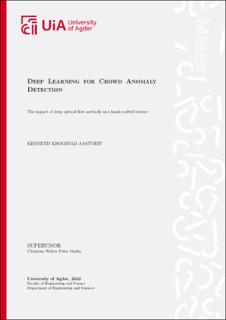| dc.description.abstract | Today, public areas across the globe are monitored by an increasing amount of surveillance cameras. This widespread usage has presented an ever-growing volume of data that cannot realistically be examined in real-time. Therefore, efforts to understand crowd dynamics have brought light to automatic systems for the detection of anomalies in crowds. This thesis explores the methods used across literature for this purpose, with a focus on those fusing dense optical flow in a feature extraction stage to the crowd anomaly detection problem. To this extent, five different deep learning architectures are trained using optical flow maps estimated by three deep learning-based techniques. More specifically, a 2D convolutional network, a 3D convolutional network, and LSTM-based convolutional recurrent network, a pre-trained variant of the latter, and a ConvLSTM-based autoencoder is trained using both regular frames and optical flow maps estimated by LiteFlowNet3, RAFT, and GMA on the UCSD Pedestrian 1 dataset. The experimental results have shown that while prone to overfitting, the use of optical flow maps may improve the performance of supervised spatio-temporal architectures. | |
